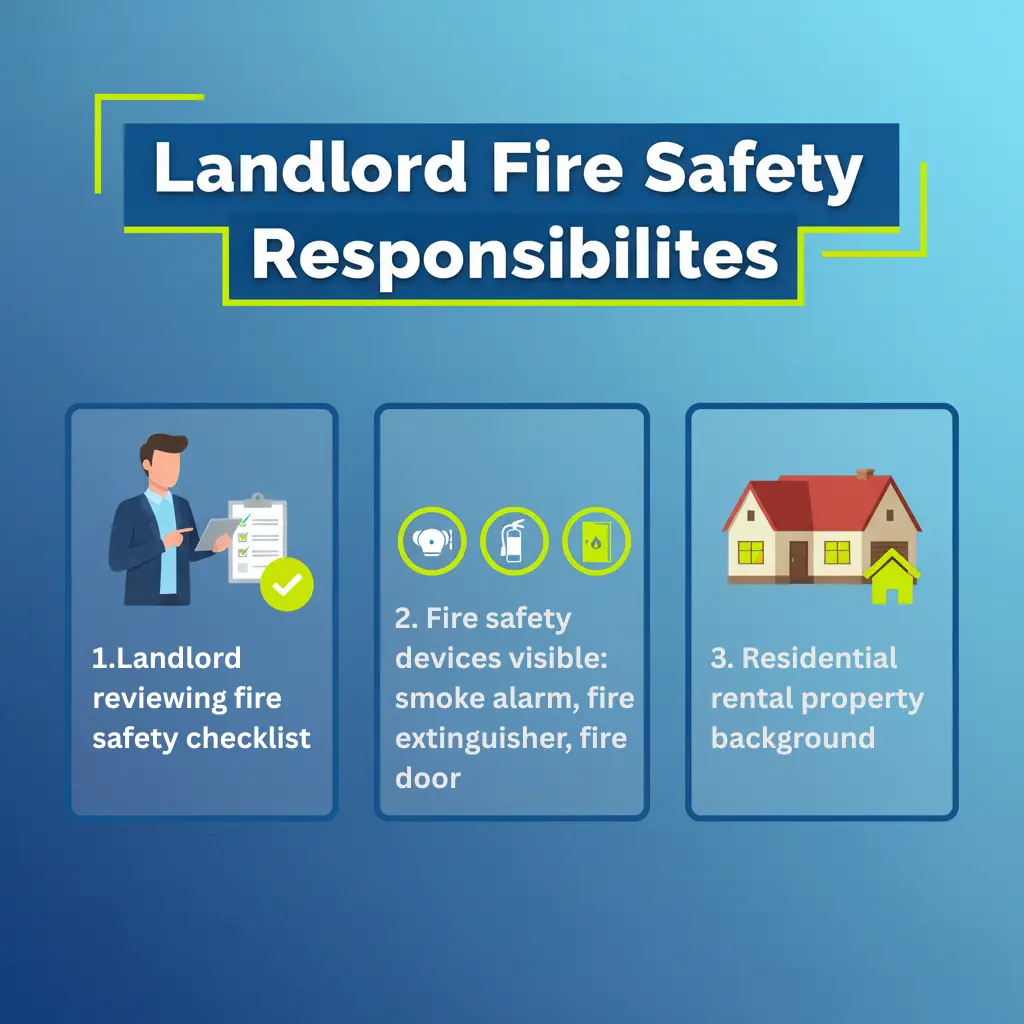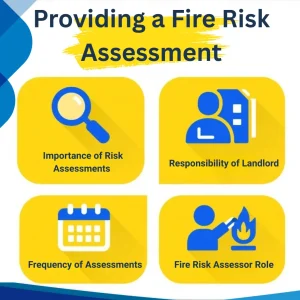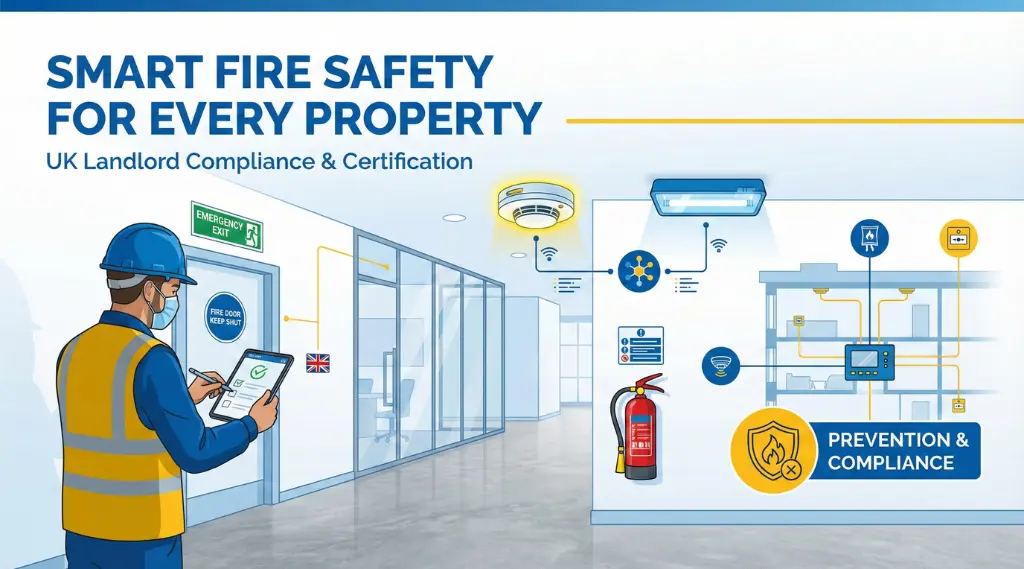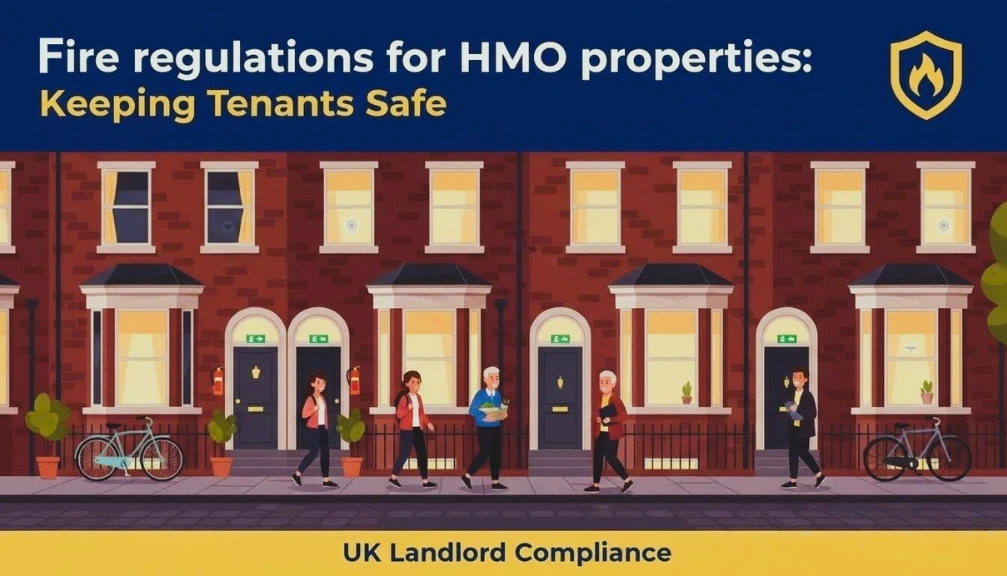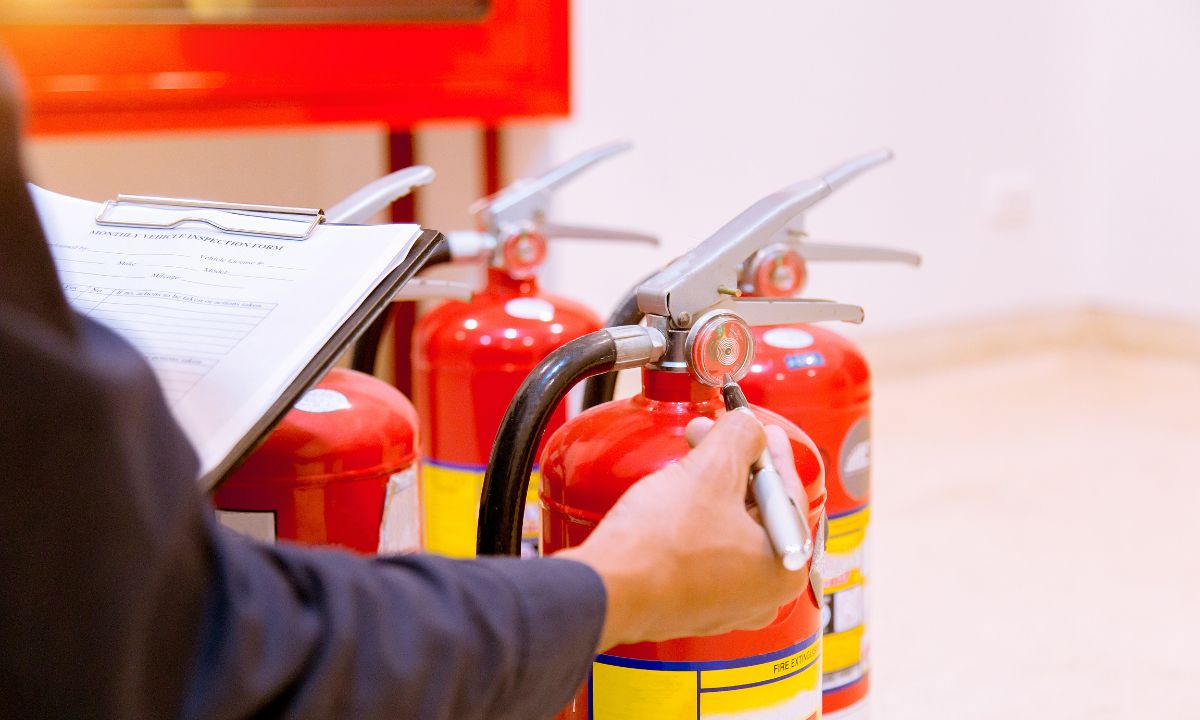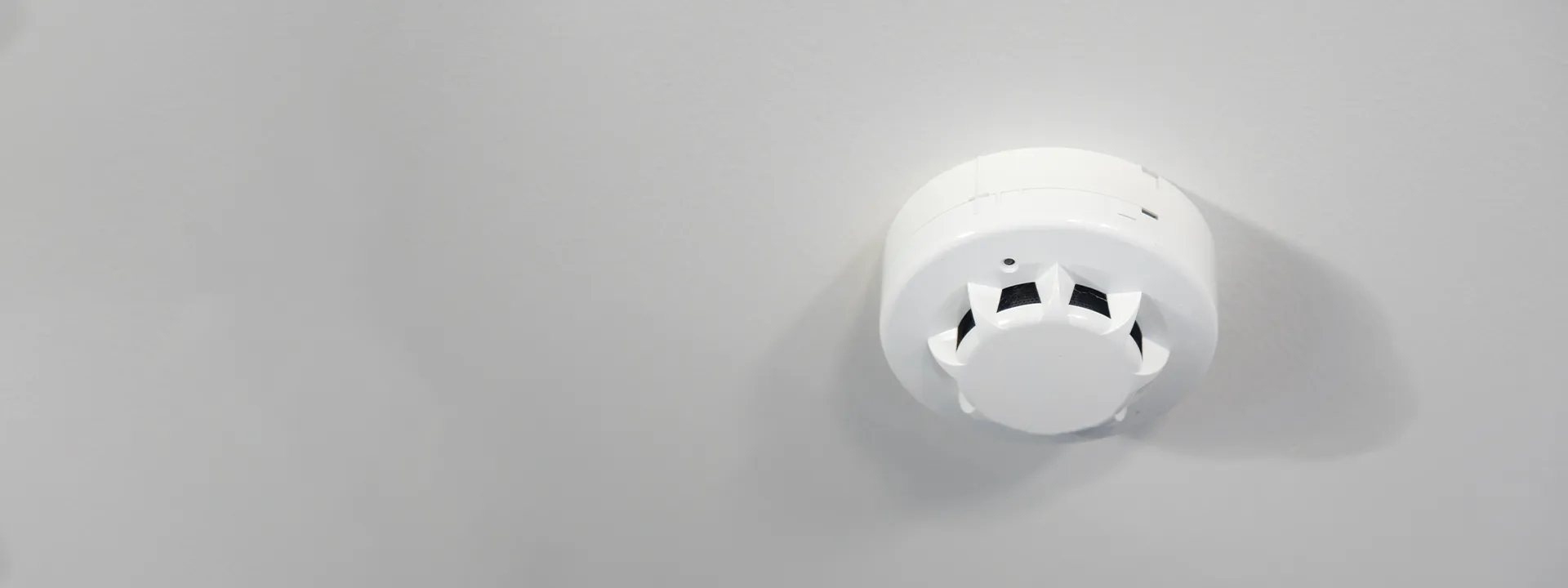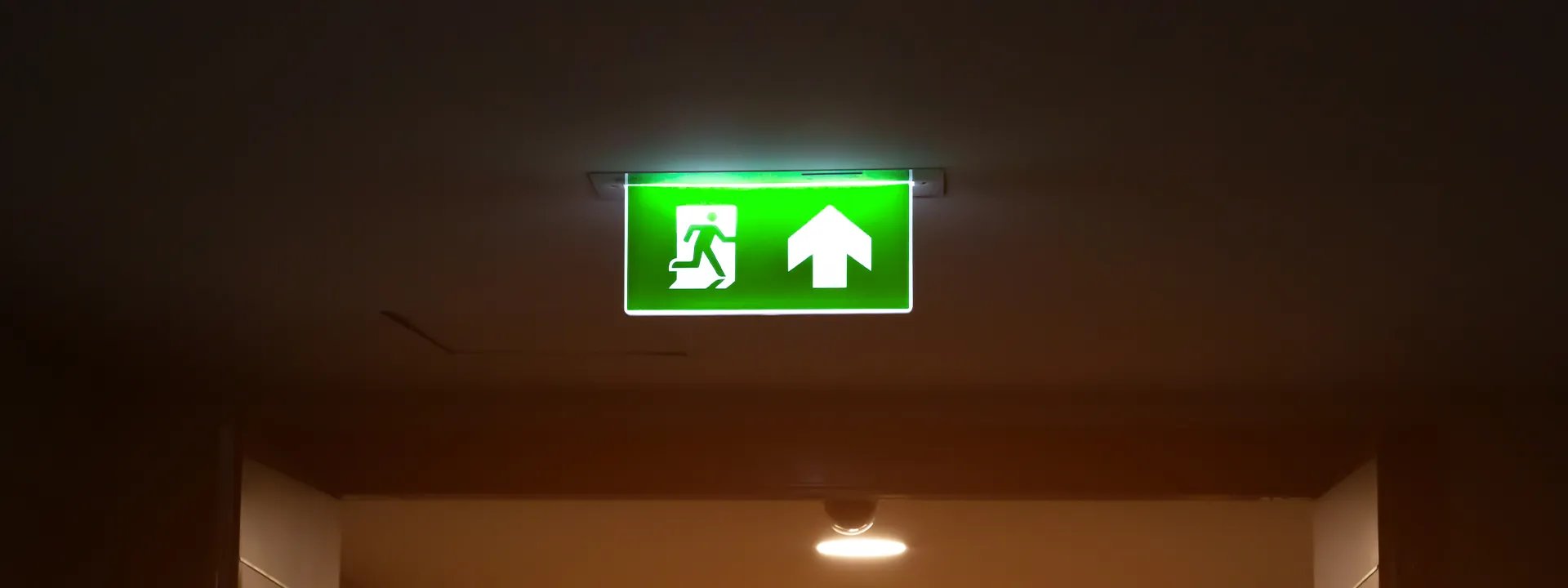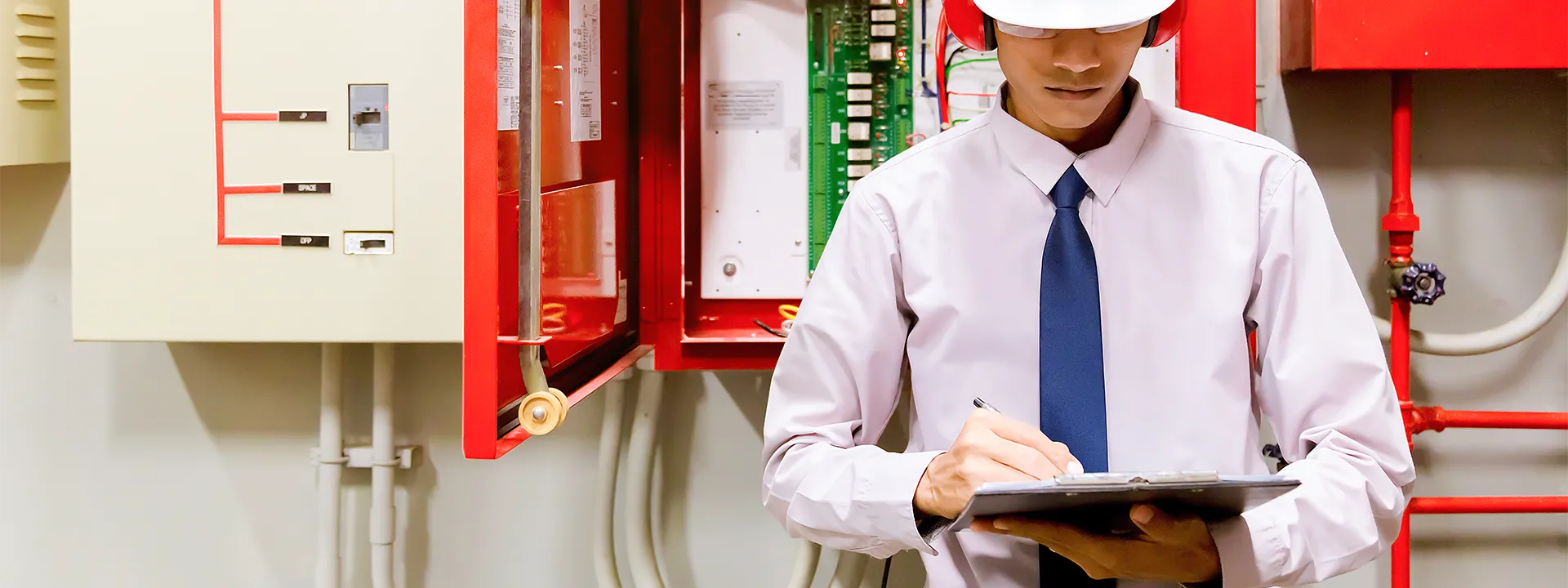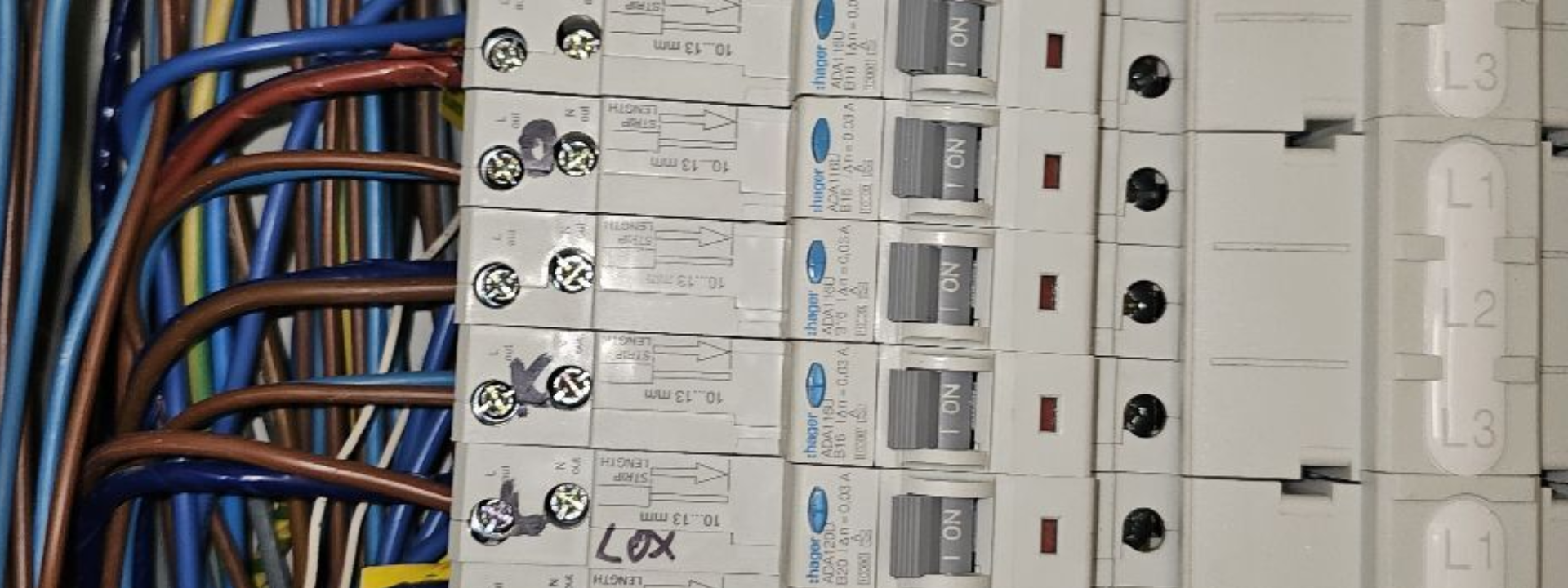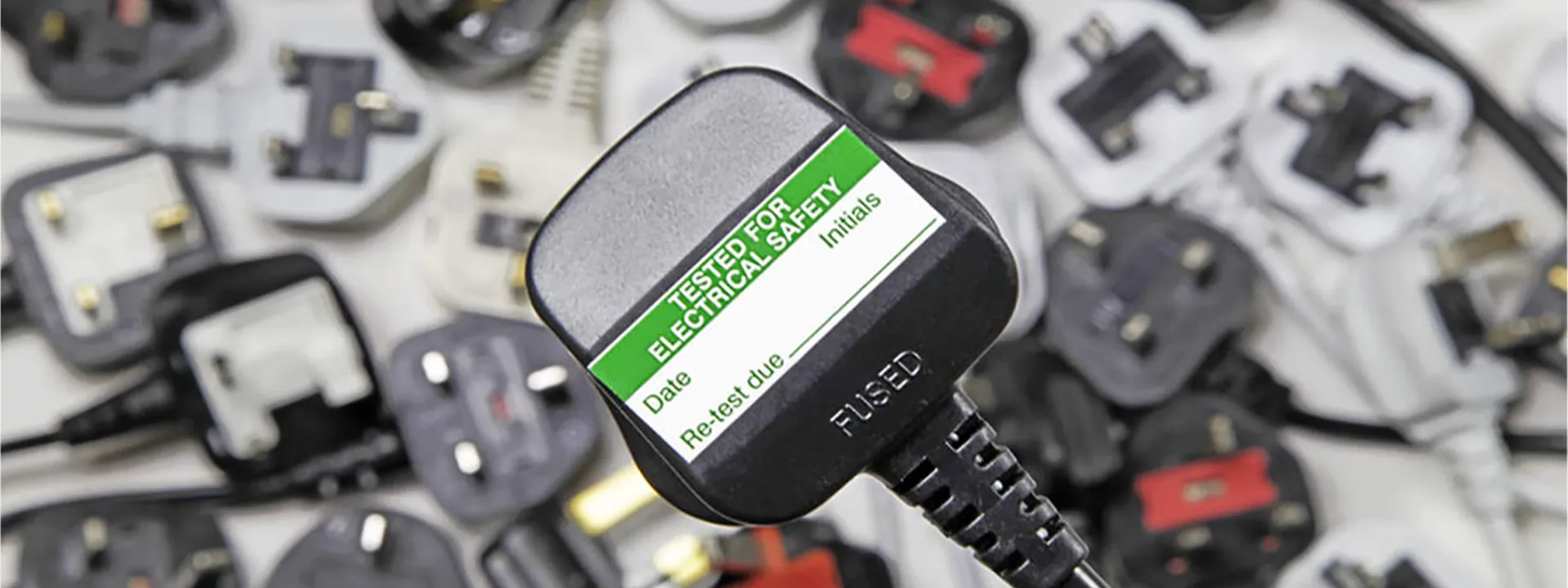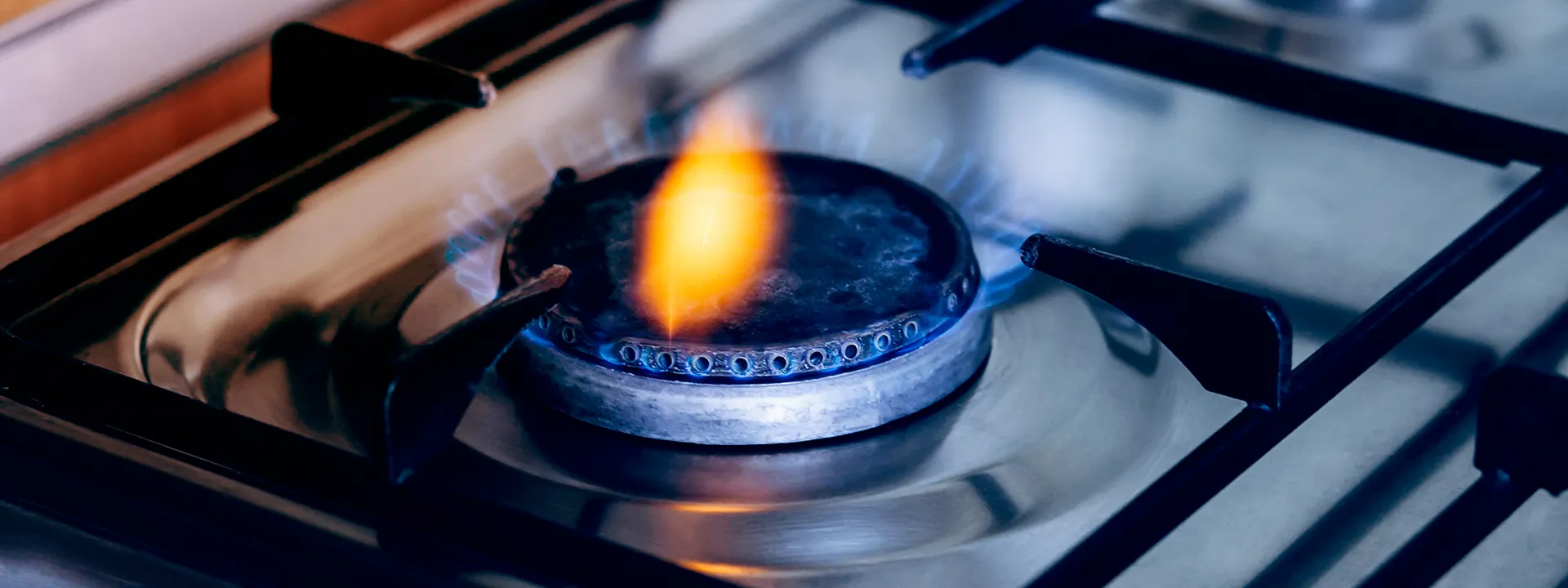If you’re a landlord, you need to know how to keep your property safe from fire. Not only the property, but you also need to take care of people. That’s why landlord fire safety responsibilities play such an important role in London.
Fire spread too fast and hurt people, pets and their property. Even a small fire can damage your property. As a landlord, your job is to ensure your tenants safety. We know you’re a landlord, that’s why you’re here.
In this guide, you’ll find out what to check, what to install, and how to make your property safer for everyone. Let’s dive into this.
What are the essential fire safety regulations for landlords?
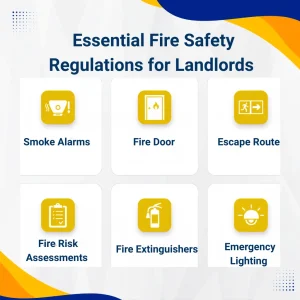
Did you know that over 80% of fire deaths occur in the home? The risk of fire is extremely high in rented properties. That’s why fire safety for landlords is a legal requirement.
If you’re a landlord in the private rented sector or managing blocks of flats, here’s what you need to know:
1. As a landlord, you need to understand your duties, like:![]() Fire detection
Fire detection![]() Alarm systems
Alarm systems![]() Fire risk assessments
Fire risk assessments![]() Escape routes
Escape routes![]() Fire doors
Fire doors![]() Emergency lighting
Emergency lighting![]() Fire extinguishers or blankets
Fire extinguishers or blankets![]() Tenant fire safety information
Tenant fire safety information![]() Fire-resistant furniture and materials
Fire-resistant furniture and materials![]() Regular checks and maintenance
Regular checks and maintenance
2. As a landlord, you must follow these legal rules:![]() Regulatory Reform (Fire Safety) Order 2005
Regulatory Reform (Fire Safety) Order 2005![]() Fire Safety (England) Regulations 2022
Fire Safety (England) Regulations 2022![]() Building Safety Act 2022
Building Safety Act 2022
Understanding the Regulatory Reform Fire Safety Order 2005
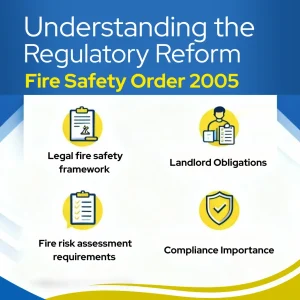
The Regulatory Reform Fire Safety Order 2005, also known as the Fire Safety Order. In this Fire Safety Order, tell what the key legal responsibilities are for landlords and property managers in London. According to this order, the responsible person or landlord must:
![]() Conduct a fire risk assessment.
Conduct a fire risk assessment.![]() Identify potential fire risks.
Identify potential fire risks.![]() Implement fire safety measures.
Implement fire safety measures.![]() Keep escape routes
Keep escape routes![]() Inform tenants of what to do in the event of fire.
Inform tenants of what to do in the event of fire.![]() Fit and maintain proper fire doors
Fit and maintain proper fire doors![]() Make a clear and simple emergency plan
Make a clear and simple emergency plan![]() Provide fire safety training to staff
Provide fire safety training to staff![]() Give fire safety information to building users
Give fire safety information to building users
In 2021, the Fire Safety Act added more rules, like building structure, flat entrance fire doors, and external walls.
Then, the more Fire Safety (England) Regulations were added in 2022. These new landlord fire safety requirements for buildings with common parts. The rules are:![]() In buildings over 11m high:
In buildings over 11m high:
Check Fire doors in communal areas every 3 months.
Check the entrance fire doors at least once a year.
![]() Give residents fire safety information every year or when things change.
Give residents fire safety information every year or when things change.![]() Make sure residents have clear evacuation instructions.
Make sure residents have clear evacuation instructions.![]() Rules apply to shared areas in blocks of flats and rented homes.
Rules apply to shared areas in blocks of flats and rented homes.![]() Responsible persons must do fire risk assessments for common areas.
Responsible persons must do fire risk assessments for common areas.![]() Take steps to reduce the risk of fire, like installing fire alarms, fire doors, and ensuring clear escape routes.
Take steps to reduce the risk of fire, like installing fire alarms, fire doors, and ensuring clear escape routes.![]() Local fire and rescue services and local authorities strictly observe it.
Local fire and rescue services and local authorities strictly observe it.
HMO fire safety requirements vs. standard rental properties
As a landlord, your priority is to keep your tenants safe from fire. To keep your people and property safe, ensure that you maintain fire safety rules properly. But not all rental properties have the same fire safety rules. Fire safety for HMO properties or shared house follow different fire safety rules. To help you understand these differences clearly, here is a simple guide:
Landlord Fire Safety Responsibility
Standard Rental Property
HMO (House in Multiple Occupation)
Smoke alarms
One on each floor
Hard-wired, linked alarms on every floor.
Heat alarms
One on each floor
Must be in every kitchen
Carbon monoxide alarms
Needed in rooms with gas or solid fuel
The same rules apply, regular checks
Fire doors
Always required
Must be fitted on escape routes and high-risk rooms
Escape routes
Must be clear and easy to use
Must be clear, lit, and clearly marked
Fire blanket or extinguisher
Recommended but not required by Law
Fire blanket in the kitchen. Extinguisher if the property is large
Emergency lighting
Recommended but not required by Law
Needed if escape routes are long or poorly lit
Fire risk assessment
Recommended but not required by law
Must be carried out and reviewed regularly
Fire alarm system
Battery-powered smoke alarms allowed
Full fire alarm system with control panel
Fire safety information
Basic safety advice is recommended
Clear fire action notices and instructions must be displayed
Landlord Fire Safety Responsibility
Standard Rental Property
HMO (House in Multiple Occupation)
Smoke alarms
One on each floor
Hard-wired, linked alarms on every floor.
Heat alarms
One on each floor
Must be in every kitchen
Carbon monoxide alarms
Needed in rooms with gas or solid fuel
The same rules apply, regular checks
Fire doors
always required
Must be fitted on escape routes and high-risk rooms
Escape routes
Must be clear and easy to use
Must be clear, lit, and clearly marked
Fire blanket or extinguisher
Recommended but not required by Law
Fire blanket in the kitchen. Extinguisher if the property is large
Emergency lighting
Recommended but not required by Law
Needed if escape routes are long or poorly lit
Fire risk assessment
Recommended but not required by law
Must be carried out and reviewed regularly
Fire alarm system
Battery-powered smoke alarms allowed
Full fire alarm system with control panel
Fire safety information
Basic safety advice is recommended
Clear fire action notices and instructions must be displayed
Penalties and consequences for non-compliance with fire safety laws
Fire safety rules are not a formality or paperwork. These rules are created to save people’s life and their property from fire. If landlords, managers, or any other responsible person ignore them, they face:
![]() Minor penalties can be up to £5,000. Major penalties can include unlimited fines. Also, up to 2 years in prison.
Minor penalties can be up to £5,000. Major penalties can include unlimited fines. Also, up to 2 years in prison.![]() Legal notices can order you to fix the problem by a certain date.
Legal notices can order you to fix the problem by a certain date.![]() Banning orders can stop you from renting out homes in the future.
Banning orders can stop you from renting out homes in the future.![]() Criminal action can follow if someone gets hurt due to poor fire safety.
Criminal action can follow if someone gets hurt due to poor fire safety.![]() Tenants can claim back rent through rent repayment orders.
Tenants can claim back rent through rent repayment orders.![]() Insurance might not cover damage if the rules are not followed.
Insurance might not cover damage if the rules are not followed.
What Are the Key Fire Safety Legal Requirements for Landlords?
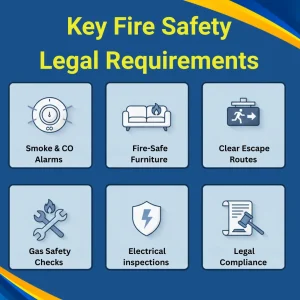
As a landlord, tenants, their people, property, and even their pets are your responsibility during a fire. There are many fire safety regulations that landlords must follow, but some requirements are more important. These include providing and maintaining smoke and carbon monoxide alarms on every floor, ensuring all furniture and furnishings are fire-safe, and keeping escape routes clear and accessible.
Mandatory Fire Safety Regulations for Residential Properties
![]() Here, we discuss the mandatory fire safety regulations for residential properties:
Here, we discuss the mandatory fire safety regulations for residential properties:![]() Follow the Building Safety Act 2022. This applies to tall buildings and flats.
Follow the Building Safety Act 2022. This applies to tall buildings and flats.![]() Follow the Fire Safety (England) Regulations 2022. This includes fire doors, alarms, and escape checks.
Follow the Fire Safety (England) Regulations 2022. This includes fire doors, alarms, and escape checks.![]() Follow the Fire Safety Order 2005. This covers shared areas like stairs and halls.
Follow the Fire Safety Order 2005. This covers shared areas like stairs and halls.![]() Book a gas safety check every year with a registered gas worker.
Book a gas safety check every year with a registered gas worker.![]() Get the full electrical system checked every five years.
Get the full electrical system checked every five years.![]() Give each tenant a copy of the gas and electrical safety papers.
Give each tenant a copy of the gas and electrical safety papers.![]() Fit one smoke alarm on each floor.
Fit one smoke alarm on each floor.![]() Place a carbon monoxide alarm near any solid fuel appliance.
Place a carbon monoxide alarm near any solid fuel appliance.
Penalties and Consequences for Non-Compliance
Do landlords properly follow the fire safety rules or not? If something is missing, as a landlord, you face:![]() Fines can hit £5000 or more for each breach.
Fines can hit £5000 or more for each breach.![]() Legal action follows if someone gets hurt in a fire.
Legal action follows if someone gets hurt in a fire.![]() Insurance won’t pay out if fire safety rules were ignored.
Insurance won’t pay out if fire safety rules were ignored.![]() Tenants can take legal action and ask for damages.
Tenants can take legal action and ask for damages.![]() Councils can take over property management.
Councils can take over property management.![]() Fire damage repairs fall fully on the landlord if safety checks were missed.
Fire damage repairs fall fully on the landlord if safety checks were missed.![]() A landlord who breaks the rules can be banned from renting again.
A landlord who breaks the rules can be banned from renting again.
Do landlords have to provide a fire risk assessment?
Yes. A fire risk assessment is one of the core fire safety responsibilities for any landlord. Landlord’s responsibilities for fire safety like checking smoke alarms, keeping escape routes clear, fixing any fire hazards, using fire-safe furniture, electrical Safety Integration, gas Safety Connection, etc.
Importance of a fire risk assessment for properties
A fire risk assessment is one of the most important steps for a landlord. Here we talk about why it’s important:![]() Helps spot potential fire risks from poor wiring, gas safety, or solid fuel appliances.
Helps spot potential fire risks from poor wiring, gas safety, or solid fuel appliances.![]() Supports decisions about fire safety equipment, layout, and escape plans.
Supports decisions about fire safety equipment, layout, and escape plans.![]() Ensures the property is safe from fire and meets legal fire safety standards.
Ensures the property is safe from fire and meets legal fire safety standards.![]() It can limit liability and legal issues if a fire or smoke incident occurs.
It can limit liability and legal issues if a fire or smoke incident occurs.![]() Checks if fire doors, alarms, and lights work properly.
Checks if fire doors, alarms, and lights work properly.![]() Plans regular safety checks and repairs.
Plans regular safety checks and repairs.![]() Shows tenants the property is well cared for.
Shows tenants the property is well cared for.![]() Makes it easy to fix problems quickly.
Makes it easy to fix problems quickly.![]() Helps avoid fines or warnings from fire safety officers.
Helps avoid fines or warnings from fire safety officers.![]() Protects both people and the building from harm.
Protects both people and the building from harm.
Who is responsible for conducting fire risk assessments?
To save people and property, a responsible person works for that. Take a look at this list of landlords fire safety responsibilities:![]() The boss or employer makes sure the fire risk assessment gets done at work.
The boss or employer makes sure the fire risk assessment gets done at work.![]() If you own a business, it is your job to check for fire risks in your building.
If you own a business, it is your job to check for fire risks in your building.![]() The landlord must arrange it or hire a certified fire risk assessor.
The landlord must arrange it or hire a certified fire risk assessor.![]() In blocks of flats, this falls to the freeholder or managing agent.
In blocks of flats, this falls to the freeholder or managing agent.![]() Local authorities or the London Fire Brigade can audit or inspect these assessments.
Local authorities or the London Fire Brigade can audit or inspect these assessments.![]() Landlords must look at fire safety in the homes they rent out.
Landlords must look at fire safety in the homes they rent out.![]() Facility managers take care of fire safety in big buildings or offices.
Facility managers take care of fire safety in big buildings or offices.![]() Health and safety staff handle fire checks and keep things safe
Health and safety staff handle fire checks and keep things safe
Frequency and updates of fire risk assessments
Landlord fire safety responsibilities include checking and updating the fire risk assessment regularly. These checks help spot anything that can cause a fire and fix it quickly.![]() Every 12 months, to make sure it stays accurate.
Every 12 months, to make sure it stays accurate.![]() When the layout or structure changes, like new walls or doors.
When the layout or structure changes, like new walls or doors.![]() If new tenants move in or the use of the property changes.
If new tenants move in or the use of the property changes.![]() After a fire incident, to improve safety.
After a fire incident, to improve safety.
When adding new furniture, appliances, or systems, landlords need to think about fire risk.
What fire safety equipment must landlords provide?

In London, landlords follow fire safety rules from the Fire Safety Order 2005. These rules are part of the landlord fire safety obligations. These rules say landlords must check fire risk (Article 9). Install a fire alarm and maintain it (Articles 13 and 17), and use fire doors (Article 14). These steps are legal duties for every landlord.
Fire alarm installation and maintenance responsibilities
A fire alarm is one of the most important tools in a fire. That’s why landlords must install and maintain a fire detection system to keep tenants safe. Landlords have these fire alarm and safety duties to follow:![]() Install a smoke alarm on each storey of the home.
Install a smoke alarm on each storey of the home.![]() Fit a carbon monoxide alarm in any room with a solid fuel burning appliance, coal fire, or wood burning stove.
Fit a carbon monoxide alarm in any room with a solid fuel burning appliance, coal fire, or wood burning stove.![]() Test all smoke and CO alarms on the first day of a new tenancy.
Test all smoke and CO alarms on the first day of a new tenancy.![]() Replace faulty or expired alarms promptly.
Replace faulty or expired alarms promptly.![]() Maintain a record of testing dates and outcomes.
Maintain a record of testing dates and outcomes.![]() Encourage tenants to report alarm malfunctions immediately.
Encourage tenants to report alarm malfunctions immediately.![]() Use tamper-proof alarms where possible to prevent removal or interference.
Use tamper-proof alarms where possible to prevent removal or interference.![]() Replace alarms in line with the manufacturer’s recommended lifespan (7-10 years).
Replace alarms in line with the manufacturer’s recommended lifespan (7-10 years).![]() Consider interlinked alarms in larger properties or HMOs for added safety.
Consider interlinked alarms in larger properties or HMOs for added safety.
Fire extinguisher requirements for different property types
Fire extinguisher landlord responsibility is essential to keep people safe. Fire extinguisher rules change depending on the type of property. Let’s break it down:
1.Residential Buildings![]() Fire extinguisher requirements for different property types include homes.
Fire extinguisher requirements for different property types include homes.![]() At least one extinguisher per floor is advised.
At least one extinguisher per floor is advised.![]() Especially essential near kitchens or garages.
Especially essential near kitchens or garages.![]() Local codes vary depending on region and dwelling size.
Local codes vary depending on region and dwelling size.
2.Commercial Properties
Commercial landlord responsibilities fire safety UK, and fire extinguisher requirements are regulated by OSHA.![]() Placement depends on square footage and hazard level.
Placement depends on square footage and hazard level.![]() Must be accessible within 75 feet (22.86 meters) of any point.
Must be accessible within 75 feet (22.86 meters) of any point.![]() Class A, B, or C extinguishers are required based on use.
Class A, B, or C extinguishers are required based on use.
3.Industrial Facilities
Fire extinguisher requirements for different property types are strict in industrial zones.![]() Facilities using flammable liquids must have Class B and C units.
Facilities using flammable liquids must have Class B and C units.![]() Units must be visible and properly mounted.
Units must be visible and properly mounted.![]() Regular inspections are mandatory for compliance.
Regular inspections are mandatory for compliance.
4.Educational Institutions
Fire extinguisher requirements for different property types cover schools and universities.![]() ABC-rated extinguishers must be placed in hallways, labs, and kitchens.
ABC-rated extinguishers must be placed in hallways, labs, and kitchens.![]() Maintenance logs must be updated monthly.
Maintenance logs must be updated monthly.![]() Placment must comply with NFPA and local codes.
Placment must comply with NFPA and local codes.
5.Healthcare Facilities![]() Fire extinguisher requirements for different property types apply to hospitals and clinics.
Fire extinguisher requirements for different property types apply to hospitals and clinics.![]() Units should be near patient rooms, kitchens, and equipment areas.
Units should be near patient rooms, kitchens, and equipment areas.![]() Must support quick access without obstruction.
Must support quick access without obstruction.![]() Types and quantity depend on building layout and risk level.
Types and quantity depend on building layout and risk level.
Emergency lighting regulations for rental properties
Emergency lighting is an essential requirement for HMOs and blocks of flats or shared homes. Here is how a landlord follows that requirement:![]() Install emergency lighting in all escape routes, including corridors, stairwells, and exit points.
Install emergency lighting in all escape routes, including corridors, stairwells, and exit points.![]() Ensure emergency lighting activates automatically during a power failure.
Ensure emergency lighting activates automatically during a power failure.![]() Use maintained or non-maintained lights as appropriate to the building type.
Use maintained or non-maintained lights as appropriate to the building type.![]() Check emergency lighting systems monthly for functionality.
Check emergency lighting systems monthly for functionality.![]() Conduct a full duration test at least once annually, simulating a real power cut.
Conduct a full duration test at least once annually, simulating a real power cut.![]() Record all tests, including date, time, and outcomes, in a fire safety logbook.
Record all tests, including date, time, and outcomes, in a fire safety logbook.![]() Ensure all light fittings are unobstructed and cleaned regularly.
Ensure all light fittings are unobstructed and cleaned regularly.![]() Replace batteries or bulbs as needed to maintain full illumination capacity.
Replace batteries or bulbs as needed to maintain full illumination capacity.![]() Ensure signage is properly lit and visible, especially “Exit” and “Fire Exit” signs.
Ensure signage is properly lit and visible, especially “Exit” and “Fire Exit” signs.
What Are a Landlord’s Responsibilities for Fire Escape Routes?
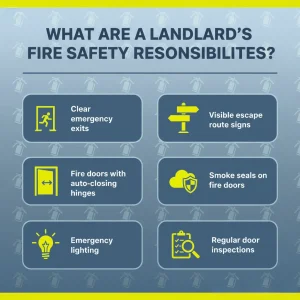
Every tenant needs a clear and fast way to escape during a fire. It’s the landlord’s duty to ensure all routes are open and easy to use. That means from the lights, a clear exit sign, and ensuring the routes are not blocked. Fire door regulations for landlords are also important. As a landlord, check that this door opens easily and is unlocked.
Fire Door Regulations and Compliance
To keep fire doors working properly, here are the key rules for landlords:![]() Install fire doors in areas like kitchens, boiler rooms, and shared hallways.
Install fire doors in areas like kitchens, boiler rooms, and shared hallways.![]() Ensure all fire doors close by themselves using a working hinge.
Ensure all fire doors close by themselves using a working hinge.![]() Add smoke seals to door edges to slow down smoke.
Add smoke seals to door edges to slow down smoke.![]() Never leave fire doors propped open with objects.
Never leave fire doors propped open with objects.![]() Inspect fire doors often for cracks, gaps, or loose fittings.
Inspect fire doors often for cracks, gaps, or loose fittings.![]() Replace or fix doors if they don’t close tightly.
Replace or fix doors if they don’t close tightly.![]() Tell tenants why fire doors matter and how to use them properly.
Tell tenants why fire doors matter and how to use them properly.
Emergency Exit Requirements
In a fire, every second is important. To keep everyone safe, here are the important emergency exit requirements landlords must follow:![]() Keep hallways and stairwells free from clutter or storage.
Keep hallways and stairwells free from clutter or storage.![]() Never block exit doors with furniture, bins, or bikes.
Never block exit doors with furniture, bins, or bikes.![]() Use doors with a bar or lever that’s easy to open from inside.
Use doors with a bar or lever that’s easy to open from inside.![]() Add emergency lights that stay on during power cuts.
Add emergency lights that stay on during power cuts.![]() Put up arrows or signs that guide people toward the exits.
Put up arrows or signs that guide people toward the exits.![]() Test exit doors to make sure they open fully and easily.
Test exit doors to make sure they open fully and easily.![]() Walk through the property now and then to spot any problems.
Walk through the property now and then to spot any problems.
Signage and Evacuation Plan Obligations
Signage and evacuation plans are essential during a fire emergency. Landlords must ensure they follow the guidelines below:![]() Create simple fire escape maps for all shared buildings.
Create simple fire escape maps for all shared buildings.![]() Place fire escape signs in hallways, stairwells, and near exits.
Place fire escape signs in hallways, stairwells, and near exits.![]() Give tenants a printed or digital guide when they move in.
Give tenants a printed or digital guide when they move in.![]() Clearly show where to go, how to get there, and what to avoid.
Clearly show where to go, how to get there, and what to avoid.![]() Include landlord and emergency contact numbers in the guide.
Include landlord and emergency contact numbers in the guide.![]() Update escape plans if the building layout changes.
Update escape plans if the building layout changes.![]() Translate signs and guides if tenants speak different languages.
Translate signs and guides if tenants speak different languages.
What are the landlord safety checks required?
For the landlord’s safety check is not important, it’s a legal duty. They must check regularly, like gas, electricity, and fire safety, to protect tenants. If landlords ignore these checks, it can lead to fines or other trouble.![]() Gas safety checks every year
Gas safety checks every year![]() Electrical system inspections regularly.
Electrical system inspections regularly.![]() Fire safety measures are in place and checked.
Fire safety measures are in place and checked.![]() Smoke alarms and carbon monoxide detectors are working.
Smoke alarms and carbon monoxide detectors are working.![]() Ensure all safety equipment is maintained.
Ensure all safety equipment is maintained.
Types of safety checks landlords must perform
In this section, we talk about those safety checks that are mandatory for landlords. Take a look at that outline below:
1.Fire Alarm Testing![]() Weekly in shared buildings (e.g. flats with communal hallways)
Weekly in shared buildings (e.g. flats with communal hallways)![]() Monthly in smaller or single-family homes
Monthly in smaller or single-family homes
2.Fire Safety Equipment![]() Annually check fire extinguishers, fire blankets, and emergency lighting.
Annually check fire extinguishers, fire blankets, and emergency lighting.
3.Gas Safety![]() Yearly gas safety checks on:
Yearly gas safety checks on:
![]() Boilers
Boilers
![]() Cookers
Cookers
![]() Heaters
Heaters![]() Must be performed by a Gas Safe registered engineer.
Must be performed by a Gas Safe registered engineer.
4.Electrical Safety![]() Every 5 years: Full Electrical Installation Condition Report (EICR)
Every 5 years: Full Electrical Installation Condition Report (EICR)![]() Includes checks of wiring, sockets, fuse boxes, and fixed light fittings
Includes checks of wiring, sockets, fuse boxes, and fixed light fittings
5. Routine Walk-throughs
Look for:![]() Damaged or missing alarms
Damaged or missing alarms![]() Broken lights
Broken lights![]() Blocked exits
Blocked exits![]() General hazards
General hazards
6. Replacement of Safety Equipment
Replace immediately if any safety item is:
![]() Expired
Expired
![]() Missing
Missing
![]() Damaged
Damaged
7. Keep Escape Routes Clear
Ensure all shared areas are free of:
![]() Storage items
Storage items
![]() Clutter
Clutter
![]() Anything obstructing emergency exits
Anything obstructing emergency exits
How often should fire safety checks be conducted?
Fire checks help keep people safe and alert. If you’re a landlord, use this list to see how often you need to check each part:![]() Fire alarm: test every month.
Fire alarm: test every month.![]() Fire extinguishers: check once a year.
Fire extinguishers: check once a year.![]() Emergency lighting: check once a year.
Emergency lighting: check once a year.![]() Gas safety: check once a year.
Gas safety: check once a year.![]() Heat detectors in kitchens: Check every month.
Heat detectors in kitchens: Check every month.![]() Fire risk assessment: update every year or when layout or tenants change.
Fire risk assessment: update every year or when layout or tenants change.![]() Fire doors: inspect every 3 months.
Fire doors: inspect every 3 months.![]() Escape routes: check during each property visit.
Escape routes: check during each property visit.
Documentation and record-keeping for safety checks
As a landlord, you keep everything clear, up-to-date, and properly recorded. That’s proof that you follow the landlord fire safety responsibilities sincerely. Here’s what you need to keep on file:![]() Write down every fire and gas safety check with dates.
Write down every fire and gas safety check with dates.![]() Store all fire risk assessments and inspection reports.
Store all fire risk assessments and inspection reports.![]() Keep copies of gas and electrical certificates.
Keep copies of gas and electrical certificates.![]() Share reports if tenants request them.
Share reports if tenants request them.![]() Have records ready during safety or council inspections.
Have records ready during safety or council inspections.![]() Update the file after every repair or safety change.
Update the file after every repair or safety change.![]() Keep backup copies in a safe location.
Keep backup copies in a safe location.
What Information Must Landlords Provide to Tenants About Fire Safety?
Tenants need simple fire safety guidelines so they know how to stay safe from fire. That’s why landlords give fire safety information for tenants to make sure they know what to do if a fire starts. This guideline helps tenants work fast and stay calm if something goes wrong. Landlords must provide:![]() Clear steps to follow during a fire.
Clear steps to follow during a fire.![]() Escape routes and where to find exits.
Escape routes and where to find exits.![]() Locations of fire alarms and extinguishers.
Locations of fire alarms and extinguishers.![]() Contact numbers for emergencies.
Contact numbers for emergencies.![]() Rules for preventing fire risks inside the building.
Rules for preventing fire risks inside the building.![]() Updates when any safety detail changes.
Updates when any safety detail changes.
Fire Safety Information Packs for New Tenants
For new tenants, fire safety guidelines need to be simple and easily understandable. Because new tenants don’t know about the building. To save them, give a clear printed sheet or digital file information pack.
Include:![]() Give a fire safety pack on the day they move in.
Give a fire safety pack on the day they move in.![]() Mark where smoke alarms, fire doors, and blankets are located.
Mark where smoke alarms, fire doors, and blankets are located.![]() Show how to open fire doors and exit the building.
Show how to open fire doors and exit the building.![]() Tell them how to report a problem with alarms or exits.
Tell them how to report a problem with alarms or exits.![]() List contact numbers for emergency help and the landlord.
List contact numbers for emergency help and the landlord.![]() Explain what the signs mean and where they lead.
Explain what the signs mean and where they lead.![]() Use pictures or maps to show escape routes.
Use pictures or maps to show escape routes.
Evacuation Procedures and Emergency Response
Every building and its tenants need to know what to do if a fire starts. As a landlord, you’re responsible for keeping everyone safe. When they know what to do, how to do it, they can save their lives. Make sure to give them clear instructions:![]() Share a printed or digital evacuation plan.
Share a printed or digital evacuation plan.![]() Mark escape routes, stairs, and meeting points.
Mark escape routes, stairs, and meeting points.![]() Explain where to go after leaving the building.
Explain where to go after leaving the building.![]() List who to call during a fire, including the fire service and landlord.
List who to call during a fire, including the fire service and landlord.![]() Show what to do if trapped or blocked.
Show what to do if trapped or blocked.![]() Remind tenants not to block fire exits or doors.
Remind tenants not to block fire exits or doors.![]() Update the plan if the building layout changes.
Update the plan if the building layout changes.
What Additional Fire Safety Responsibilities Apply to Commercial Landlords?
Commercial landlords follow some extra important duties to keep their buildings safe from fire. Their property must align with fire safety rules and fire equipment. Keeping checks regularly and ensuring clear escape routes are mandatory to protect tenants and visitors.
Commercial Property-Specific Fire Regulations
According to the Regulatory Reform (Fire Safety) Order 2005 in the UK, have specific commercial property fire regulations. These duties mainly fall under Articles 8, 9, 11, 13, 14, and 17 of the Order. Take a look at those regulations:
- Article 8 – General Fire Precautions
You must take general fire safety measures to protect people on the premises. - Article 9 – Fire Risk Assessment
You must carry out and regularly review a fire risk assessment to identify and reduce risks. - Article 11 – Fire Safety Arrangements
You need proper plans and arrangements in place to manage fire safety (like staff roles and procedures). - Article 13 – Fire-Fighting and Detection
The building must have the right fire detection systems and fire-fighting equipment (like alarms and extinguishers). - Article 14 – Emergency Routes and Exits
Emergency exits and routes must be clear, safe, and well-marked, so people can escape quickly in a fire. - Article 17 – Maintenance
All fire safety systems and equipment must be properly maintained and kept in working order.
Working with Fire Safety Inspectors
Fire safety inspectors visit your property without warning. That’s why understanding fire safety inspector duties and responsibilities can help you avoid fines. They check everything, like documents, safety equipment, emergency routes, and how well you manage risks. Here’s what to Do When a Fire Inspector Visits:![]() Let inspectors see all fire safety records and checklists.
Let inspectors see all fire safety records and checklists.![]() Walk them through exits, alarms, and shared areas.
Walk them through exits, alarms, and shared areas.![]() Fix any issues quickly once they’re pointed out.
Fix any issues quickly once they’re pointed out.![]() Take notes during the visit and act on feedback.
Take notes during the visit and act on feedback.![]() Save all paperwork, even small notes or comments.
Save all paperwork, even small notes or comments.![]() Answer honestly and clearly when asked questions.
Answer honestly and clearly when asked questions.![]() Ask for guidance if something is unclear or needs improvement.
Ask for guidance if something is unclear or needs improvement.
Insurance Requirements Related to Fire Safety
Fire safety is directly connected to your insurance. Fire damage are too expensive, that’s why having insurance is important. But if you can’t prove that you follow the fire safety rules properly, the insurance company rejects the claim. As a landlord keep your fire safety records clear and updated. Here’s how:![]() Keep all reports from fire checks and inspections in one place.
Keep all reports from fire checks and inspections in one place.![]() Follow every step listed in your insurance policy.
Follow every step listed in your insurance policy.![]() Make sure alarms work and keep proof they were tested.
Make sure alarms work and keep proof they were tested.![]() Match your safety records to how the building is used.
Match your safety records to how the building is used.![]() Give your insurer all the fire safety documents they need.
Give your insurer all the fire safety documents they need.![]() Write down the exact date of each repair or check.
Write down the exact date of each repair or check.![]() Read your policy carefully so you know what to do.
Read your policy carefully so you know what to do.
What Are the Consequences of Non-Compliance with Fire Safety Regulations?
Fire safety is not a choice; it’s a legal duty for landlords. If a landlord ignores fire rules, they put lives in danger, break the law, and cause loss. And the consequences are:![]() Risk to life – People can be seriously injured or killed in a fire.
Risk to life – People can be seriously injured or killed in a fire.![]() Big fines – Landlords can be fined up to £30,000 or more per offence.
Big fines – Landlords can be fined up to £30,000 or more per offence.![]() Legal action – Courts can charge landlords or ban them from renting homes.
Legal action – Courts can charge landlords or ban them from renting homes.![]() Insurance loss – Claims can be denied if fire safety rules weren’t followed.
Insurance loss – Claims can be denied if fire safety rules weren’t followed.![]() Property shut down – Fire services can close unsafe parts of the building.
Property shut down – Fire services can close unsafe parts of the building.
Penalties and Fines for Fire Safety Violations
Breaking fire safety rules is a serious legal offence for landlords. They’re responsible for keeping every tenant safe. As a landlord, you face:![]() Fines reach £30,000 or more for each breach.
Fines reach £30,000 or more for each breach.![]() Councils can issue notices that force fast repairs.
Councils can issue notices that force fast repairs.![]() A serious breach can lead to court charges.
A serious breach can lead to court charges.![]() Judges can issue bans on managing or renting homes.
Judges can issue bans on managing or renting homes.![]() Fire services can close unsafe areas of the building.
Fire services can close unsafe areas of the building.![]() Tenants stop paying rent if homes are unsafe.
Tenants stop paying rent if homes are unsafe.![]() Legal costs add up if cases go to court.
Legal costs add up if cases go to court.
Insurance Implications of Fire Safety Negligence
Insurance only works if the landlord’s fire safety rules are followed. When those rules are ignored, it brings you a financial risk, these are:![]() Missing smoke alarms void the policy in many cases.
Missing smoke alarms void the policy in many cases.![]() Skipping required checks makes claims invalid.
Skipping required checks makes claims invalid.![]() Insurance does not cover damage caused by clear neglect.
Insurance does not cover damage caused by clear neglect.![]() Full repair and rebuild costs fall on the landlord.
Full repair and rebuild costs fall on the landlord.![]() Lost rental income is not paid without valid cover.
Lost rental income is not paid without valid cover.![]() Tenants claim damages from the landlord directly.
Tenants claim damages from the landlord directly.![]() Future insurance costs more or will be denied.
Future insurance costs more or will be denied.
As a landlord, fire safety is your responsibility. Ensure you’re fully compliant with the latest regulations and protect your tenants and property. AllLandlordCertificates.co.uk offers professional services for Domestic Electrical Safety Certificates, Commercial Electrical Safety Certificates, Gas Safety Certificates (CP12), Emergency Lighting Certificates, Fire Alarm Certificates, and EPC Certificates to keep you legally safe. Don’t risk fines or property damage. Contact All Landlord Certificates today for your fire safety needs.
